
Installation view of Tschabalala Self, Yellow Legs on Milk Crate No. 2, 2023. Photo by Tom Harris.
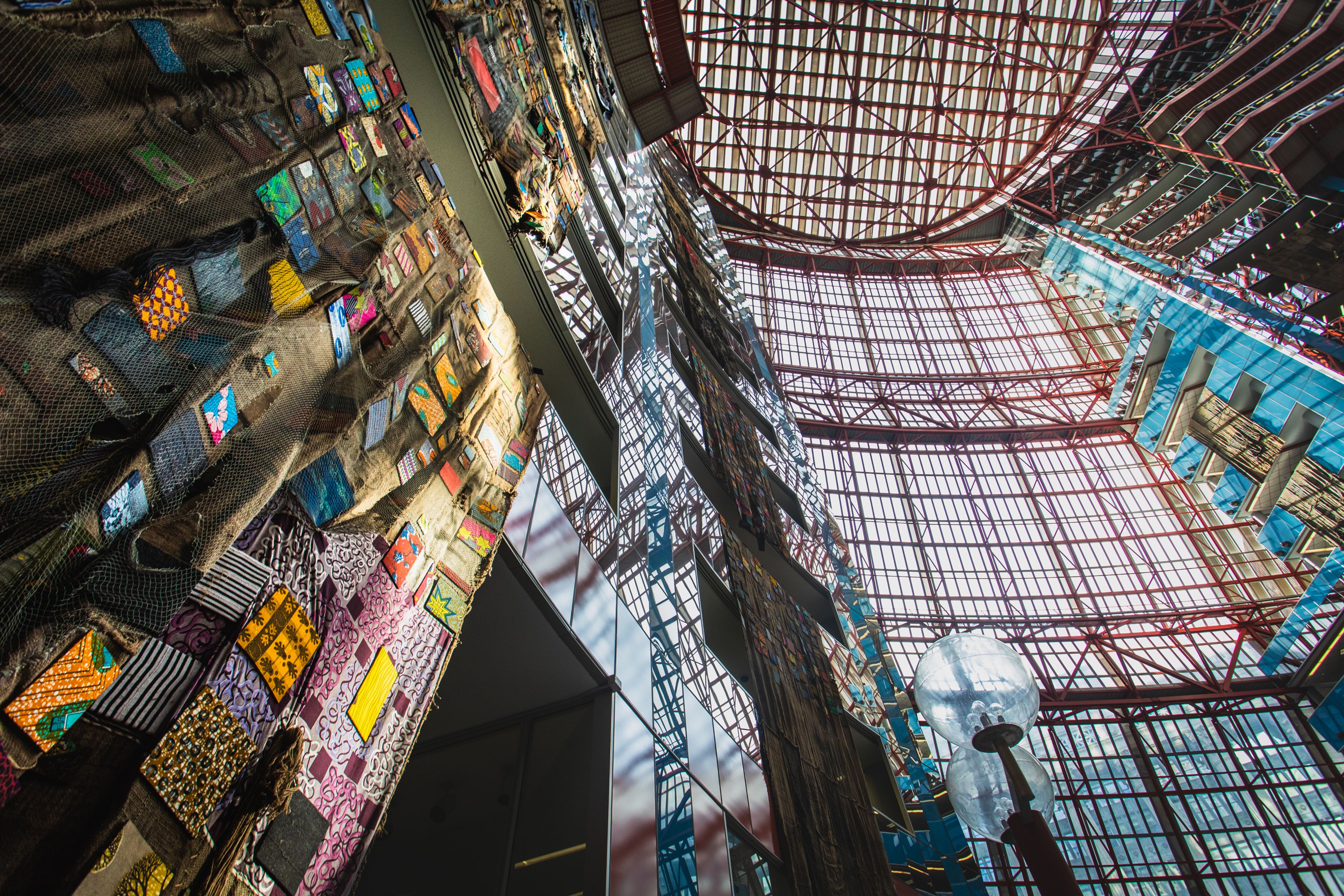
Imbrahim Mahama's site-specific installation in the atrium of the Thompson Center. Photo by Cory Dewald.
For decades, Chicagoans have known the James R. Thompson Center as a public place they visited often, whether to renew their driver’s license, take care of other bureaucratic minutiae, or go underground to grab a sandwich and catch the subway — there are tunnels connected to the CTA directly underneath the building. The moment the Helmut Jahn-designed center landed in downtown Chicago in 1985, it became the State of Illinois’ ersatz townsquare, an endearingly flashy ode to the purported openness of local government. Shaped to the street like a supersized conical glass vessel from another galaxy, its hollow, oculus-topped interior brings to mind a playful post-modern cathedral. There was no denying the shock of the building’s blue-and-salmon color scheme or the civic generosity of that soaring 17-story atrium, open to everyone, but significant real-world problems plagued Thompson Center from the start, including faulty air conditioning and non-insulated windows in a city that gets both very hot and very cold. Its inefficiency and high maintenance costs led to the building’s closing last year after it was put up for sale by the city in 2019. A drastic overhaul is poised to convert the structure into Google’s new Chicago headquarters by 2026, demolishing and replacing some of its signature features. Last month, the Thompson opened to the public one last time in the condition locals fondly recall, briefly repurposed into an exhibition and party venue for the Chicago Architecture Biennial’s currently-underway fifth edition.
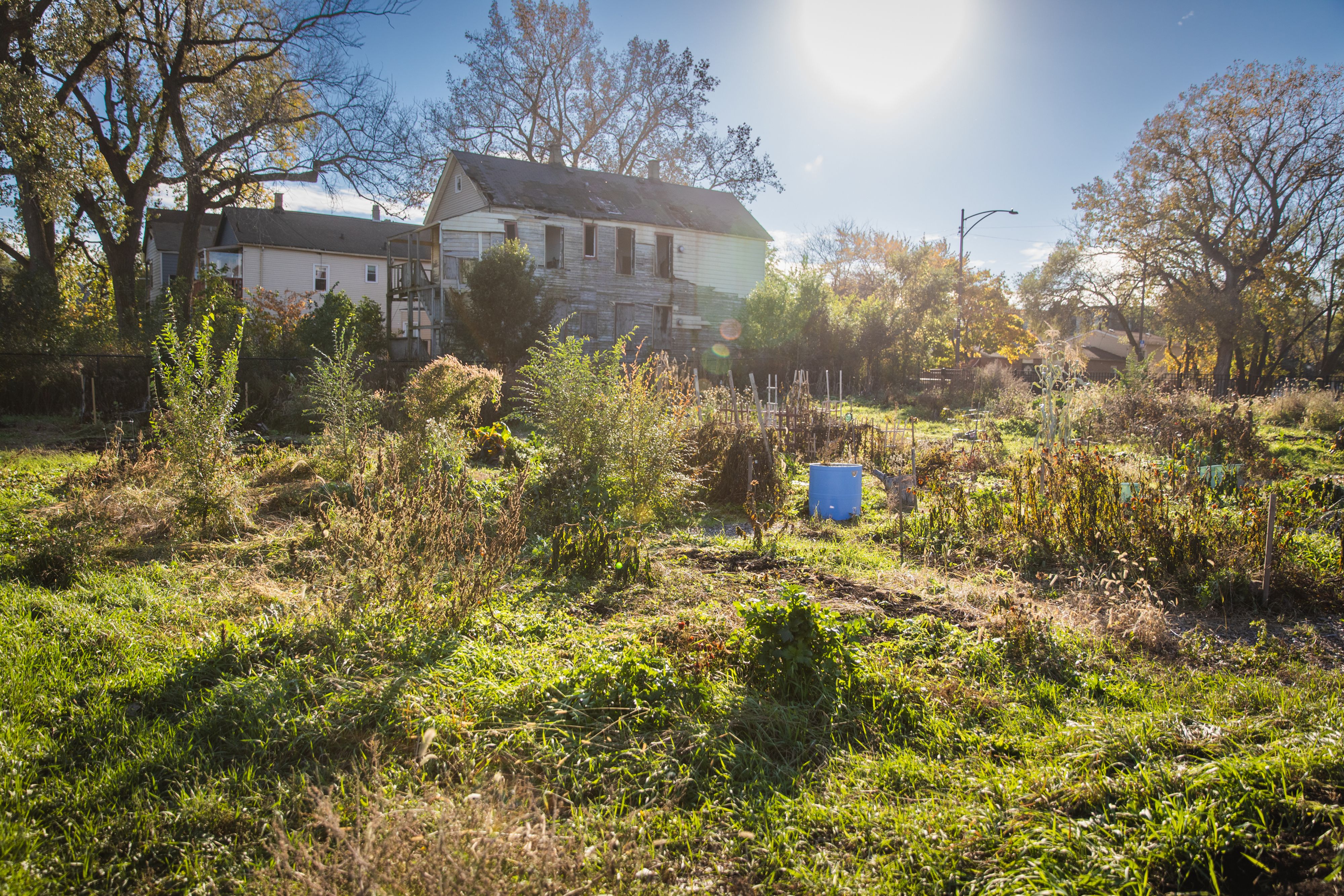
Urban Growers Collective led by Erika Allen. Photo by Cory Dewald.
CAB 5, as it is known, takes place at four more core venues along with installations at a bevy of partner sites strewn across the city. To take in everything technically part of the biennial, you have to travel from Garfield Park to the Gold Coast and from Devon Avenue to Bronzeville. If it’s all rather scattered, improvised, amorphous, and at times unfinished, the organizers insist that’s the point. The biennial’s title is This is a Rehearsal, and using the extended metropolis as the festival’s living site is one of its stated missions. Eighty-six practitioners from ten countries participated in this year’s edition, whose artistic direction was entrusted to Floating Museum, a community-oriented collective led by the poet avery r. young, the architect Andrew Schachman, and the artists Faheem Majeed and Jeremiah Hulsebos-Spofford. The team’s aim to explode the traditional exhibition format and invest in the city’s constituents is laudable, though I encountered multiple locals who had no idea the event was taking place. In a town full of pedigreed architectural greatness — a profusion of Mies, Wright, and Sullivan, not to mention the world’s tallest skyscraper designed by a woman (Jeanne Gang’s St. Regis) — nothing on view at the biennial reflects the surrounding excess of boldface Architecture for elites. In fact, the biennial actively eschews what most people think of as architecture, expanding the discipline’s definition to encompass and shine a spotlight on a diverse range of collaborative, anti-hierarchical, neighborhood-facing ventures, such as urban crop harvesting and tool-lending. Curatorially, it’s a valiant effort, but also harder to pull off cohesively than a standard building show.
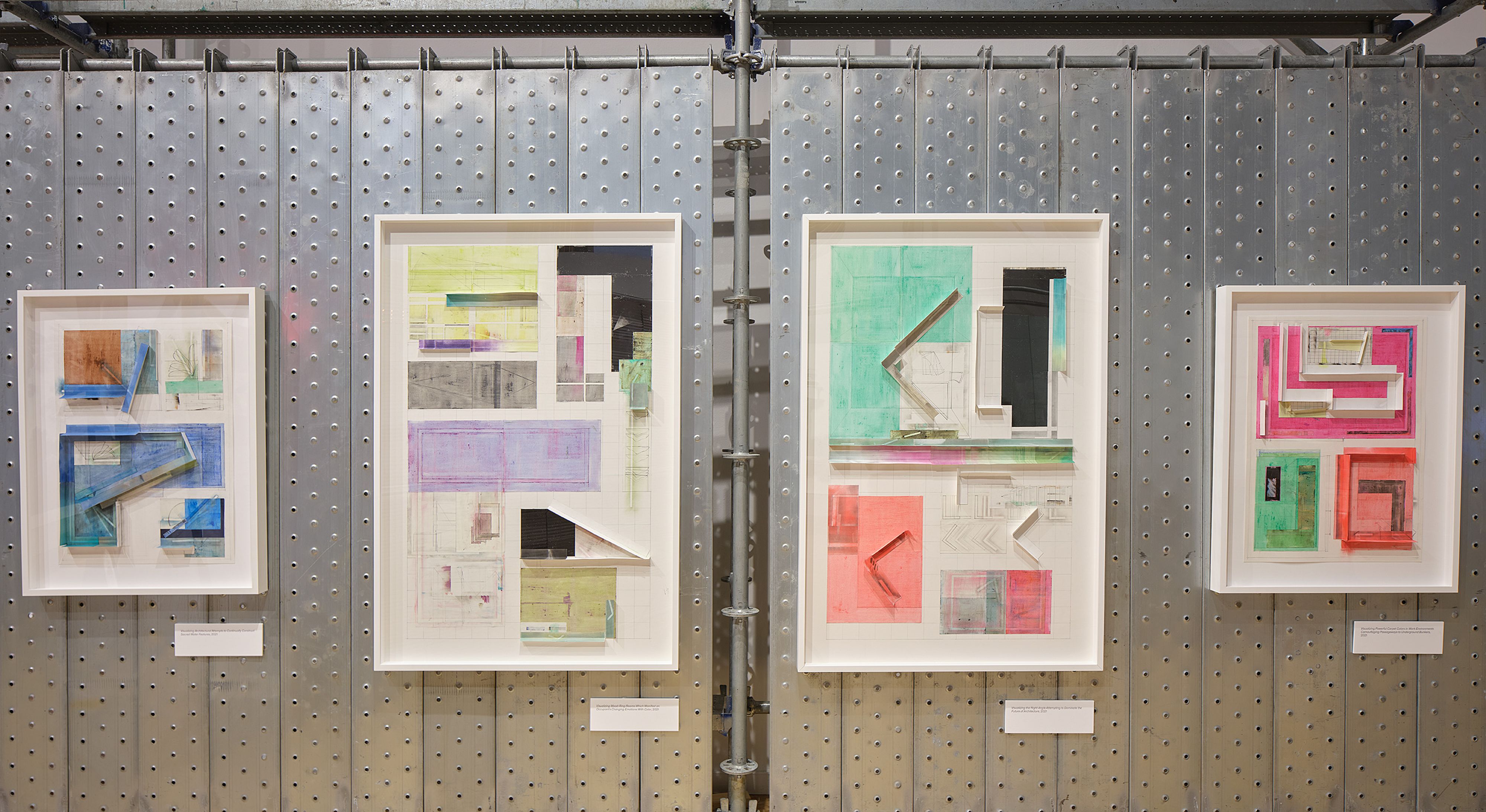
Deb Sokolow, Schematics and Speculation, 2014-2021. Photo by Tom Harris.
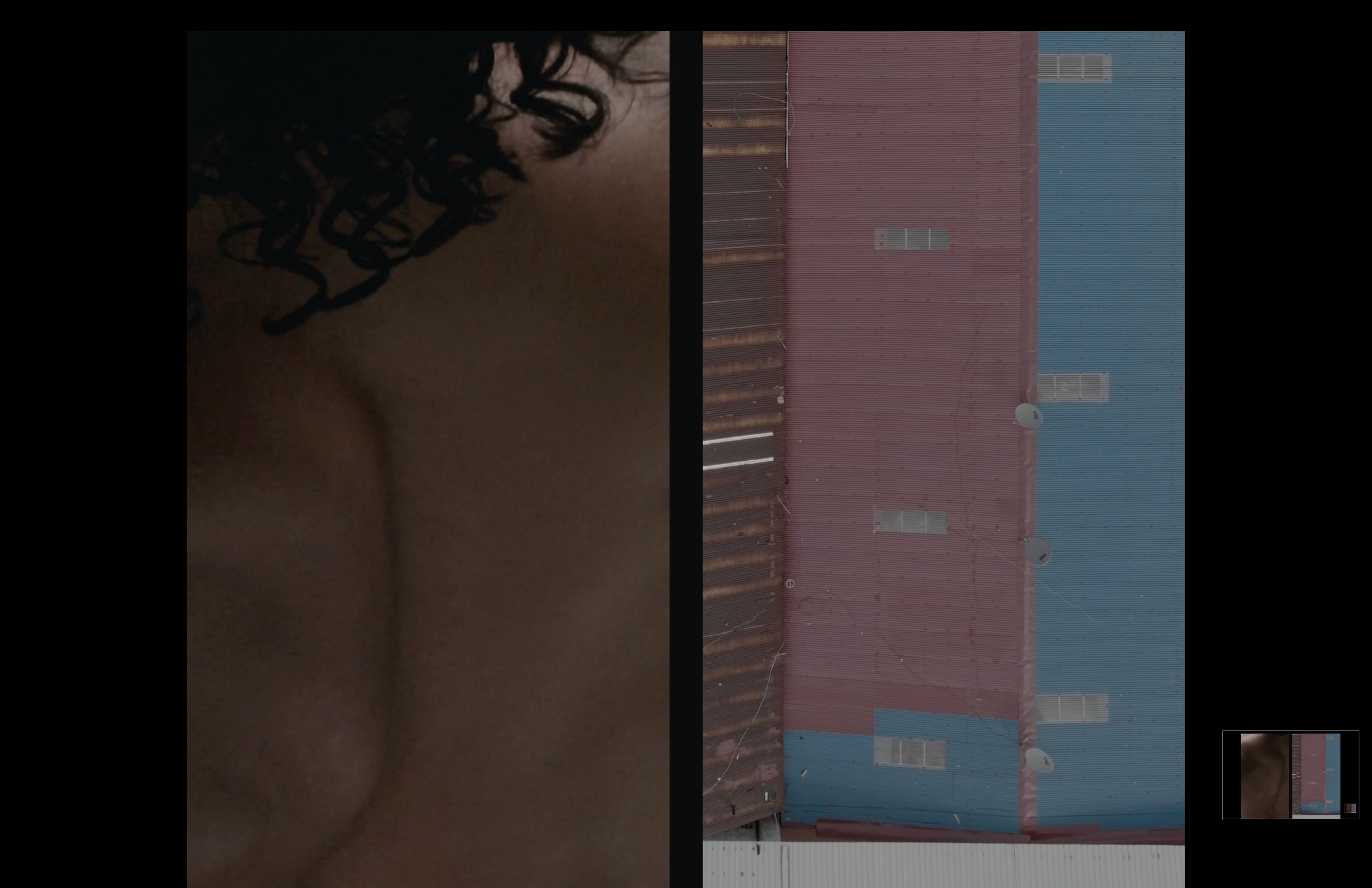
A still from SKETCH's The distance between two points is not always a straight line, 2023. Courtesy of SKETCH.
The biennial’s hub remains, as in past years, the Chicago Cultural Center (CCC), a magnificent neo-classical 1897 edifice facing Millennium Park. Here, a warren of rooms contains the current iteration’s most conventionally ‘architectural’ presentations. Among them, Deb Sokolow’s maquette-like renderings subject obscure corners of architecture trivia, like Frank Lloyd Wright’s misogynistically unstable secretaries’ chairs, to an amusing feminist revision, while Gamaliel Rodriguez’s enigmatic, synthetic landscapes appear to drown stranded airport terminals and towers in a sea of saturated cerulean ink. Some submissions are invitingly immersive, such as William O’Brien Jr.’s translucent mesh rehearsal space and Berlin practice Barkow Leibinger’s bundled cardboard tubes. Modeled after a 1923 construction by Kurt Schwitters, Leibinger’s installation encourages architects to take advantage of the surfeit of Amazon packaging the pandemic-driven rise in online shopping has unleashed on the planet. A number of videos engaging with space include stylishly political meditations on the work of Le Corbusier and Oscar Niemeyer, and more convincingly, a pared-down entry by the young Panama-based architecture firm SKETCH, which distills the small country’s economic disparity into a stirring diptych. On one screen, drone images highlight the contrast of Panama City’s moneyed business district, whose skyscrapers — housing international finance corporations and shell companies — tower jarringly over the impoverished areas that are home to a quarter of Panama’s population. The second channel imagines a new generation escaping this inequity, featuring an entrancing solo dance by José Garrido, the first-ever graduate from a program that helps vulnerable teenagers develop body awareness and mental resilience through movement. “The built environment can either perpetuate or help alleviate social injustice. We like to engage in projects that counteract the negative effects of urban planning by repairing the social fabric,” SKETCH told PIN–UP about their work.
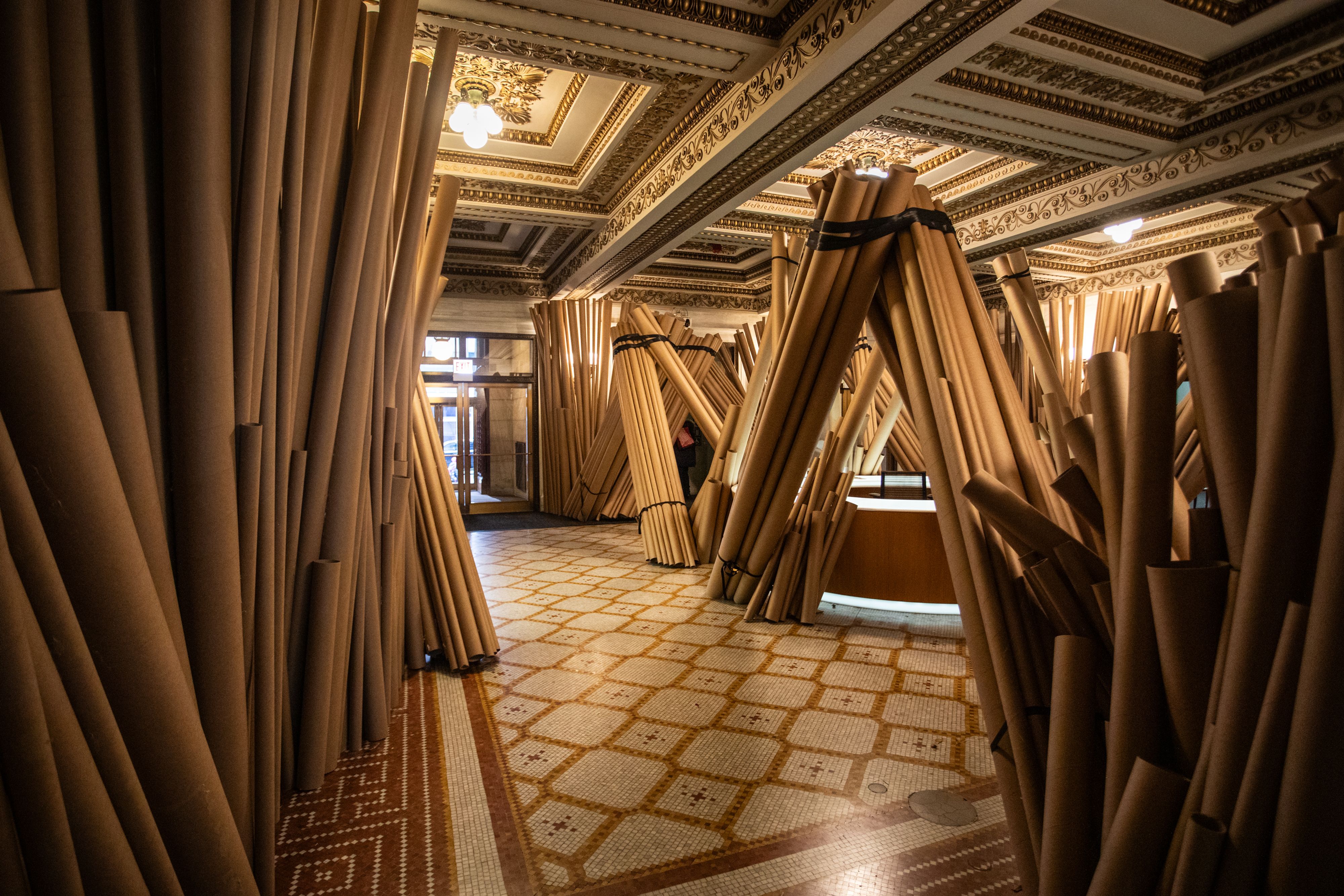
Barkow Leibinger, Cardboard Merzbau, 2023. Photo by Cory Dewald.
The grand proportions of the Cultural Center’s regal Yates gallery is a fitting backdrop for an exploration of what monuments should look like, as old templates are toppled down from Antwerp to Baghdad. In an undisputed crowd-pleaser, good old Mies van der Rohe’s iconic Crown Hall is cleverly reinvented as a coffin by the master artisan Paa Joe, one of several Ghanaian participants. While some have read the piece as a commentary on the German-born architects’s fading relevance, Paa’s son Jacob told me his family is in the business of making ‘fantasy coffins’ that honor the deceased’s passions in life — so the Miesian coffin is simply meant to be an architecture-lover’s final dream. (Interestingly, however, the ‘less-is-more’ master already got a very different funerary treatment decades ago, which does make one wonder…). Nearby, artist Chris Bradley presents a tower improbably constructed of hundreds of cast-bronze ‘pretzel’ sticks. But a voluptuous, undeniable yellow sculpture by Tschabalala Self feels most urgently potent — an arguable requirement for future monuments, one can hope. “It speaks to my understanding of a modern monument that represents a collective as opposed to one individual. The truncated curvy figure on a milkcrate abstracts the Black female body in metropolitan space,” Self told me about her contribution.

Installation view of Tschabalala Self, Yellow Legs on Milk Crate No. 2, 2023. Photo by Tom Harris.
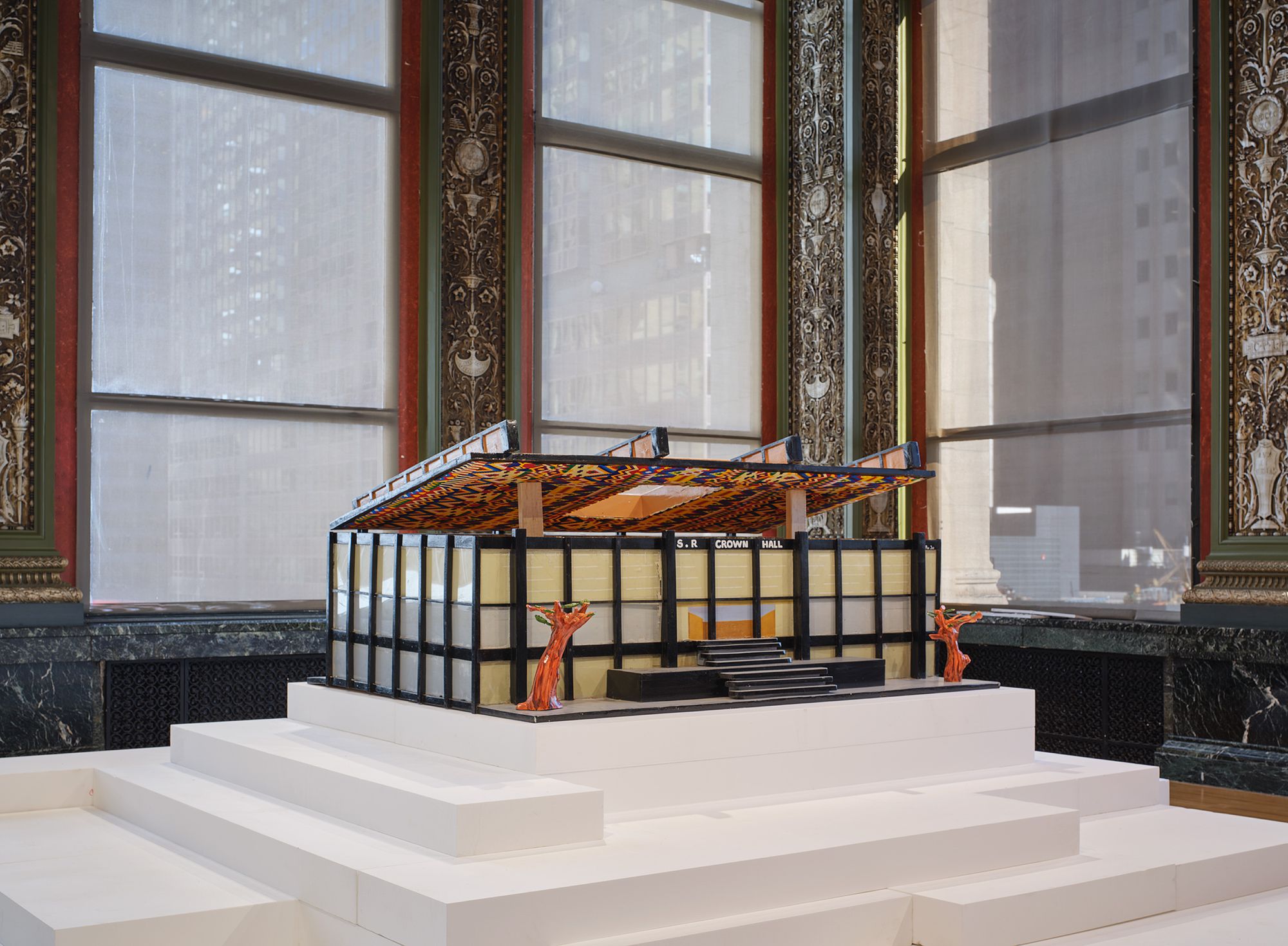
Paa Joe, Restoring Old Houses, 2023. Photo by Tom Harris.
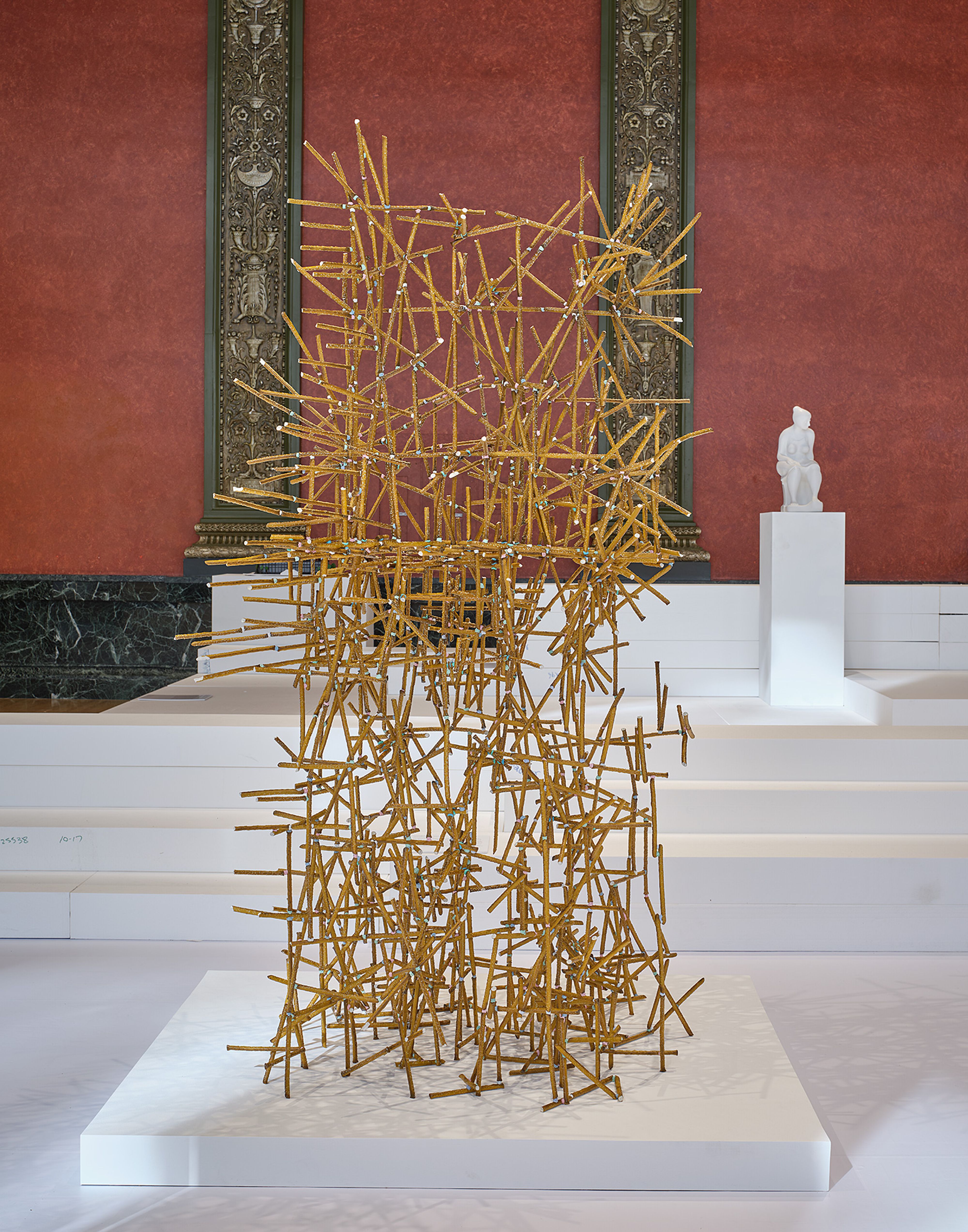
Chris Bradley, Mnemonic, 2022. Photo by Tom Harris.
Another anchor theme, ‘land,’ is represented effectively (and somewhat forbiddingly) in an installation by Columbia University’s Buell Center and AD-WO. The striking, formally sophisticated piece takes up an entire double-height room to examine the ramifications — on notions of value and property — of the Gunter’s chain, a tool used by colonial land surveyors beginning in the 17th century. As visually impactful as 100 Links: Architecture and Land, in and out of the Americas is, the long history of land-related injustices, specifically segregationist zoning laws, and their lasting implications in Chicago and other U.S. cities, resonates more evocatively in the work of Amanda Williams. The trained architect, known for color-rich investigations on the way race shapes the built environment, planted over 100,000 red tulips in some of the vacant lots that abound in Chicago’s South Side. The lots weren’t always empty — the Black-owned homes that once stood on them fell into disrepair and were torn down as a result of redlining. William’s tulips bloomed last spring and had wilted by the time the biennial opened, but affecting exhaustive documentation of the project is on view at the Cultural Center. When I spoke with Williams, she said that CAB’s inaugural 2015 edition, “spring-boarded recognition of my practice. Coming back years later with my ongoing redlining project, [I thought] it would be disingenuous to present a thought as complete when it’s unfolding at a pace that is often uncomfortable to the profession and to audiences. I used the biennial and its rehearsal frame to experiment with showing something in progress. Architects are not normally allowed to display incompleteness — we are expected to tidy things up. The invisible part of my project is building community trust, so perhaps the poetry of the fields will gradually translate to policy and power.”
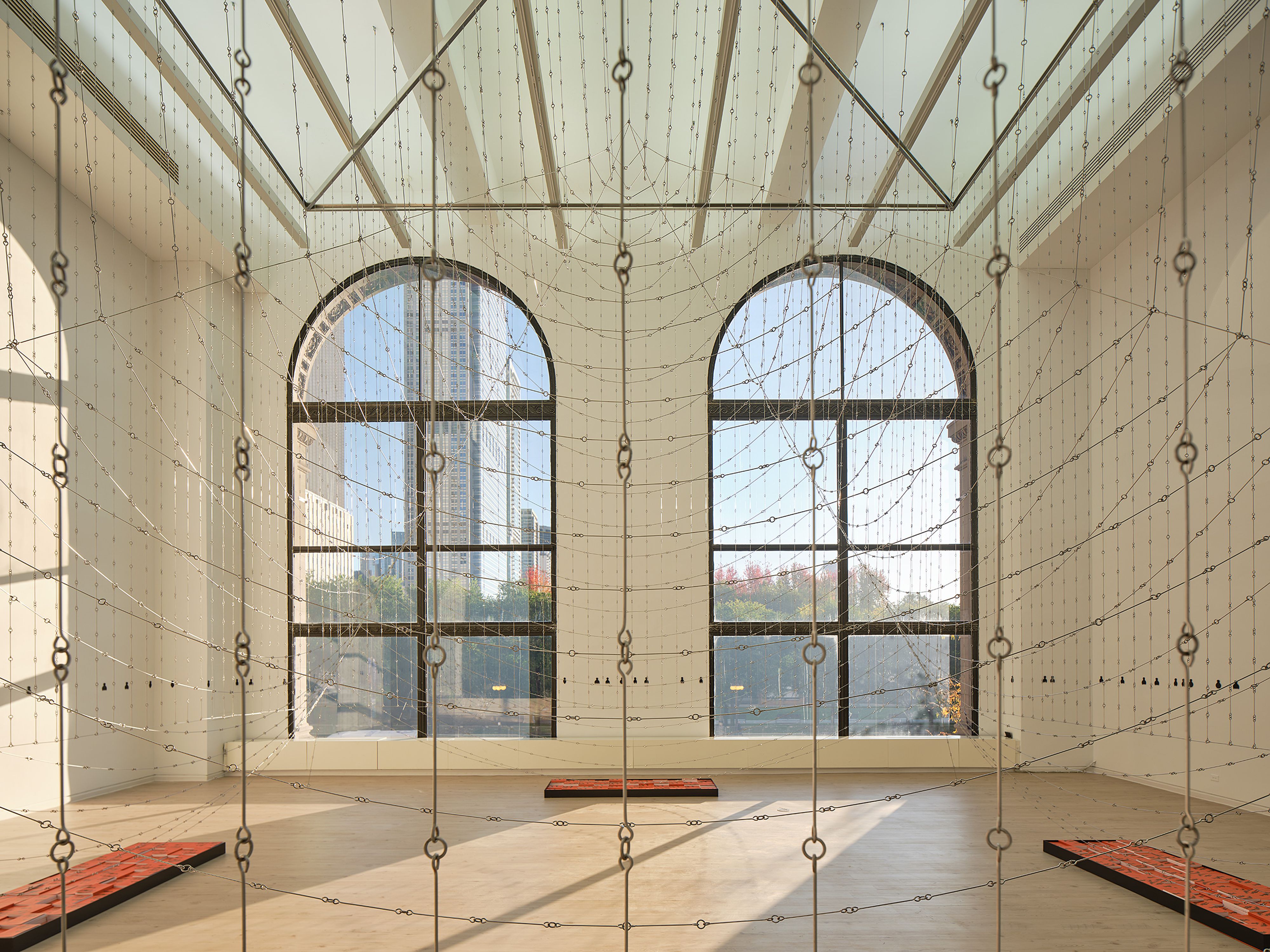
The Buell Center and AD—WO, Columbia University, 100 Links: Architecture and Land, in and out of the Americas, 2023. Photo by Tom Harris.
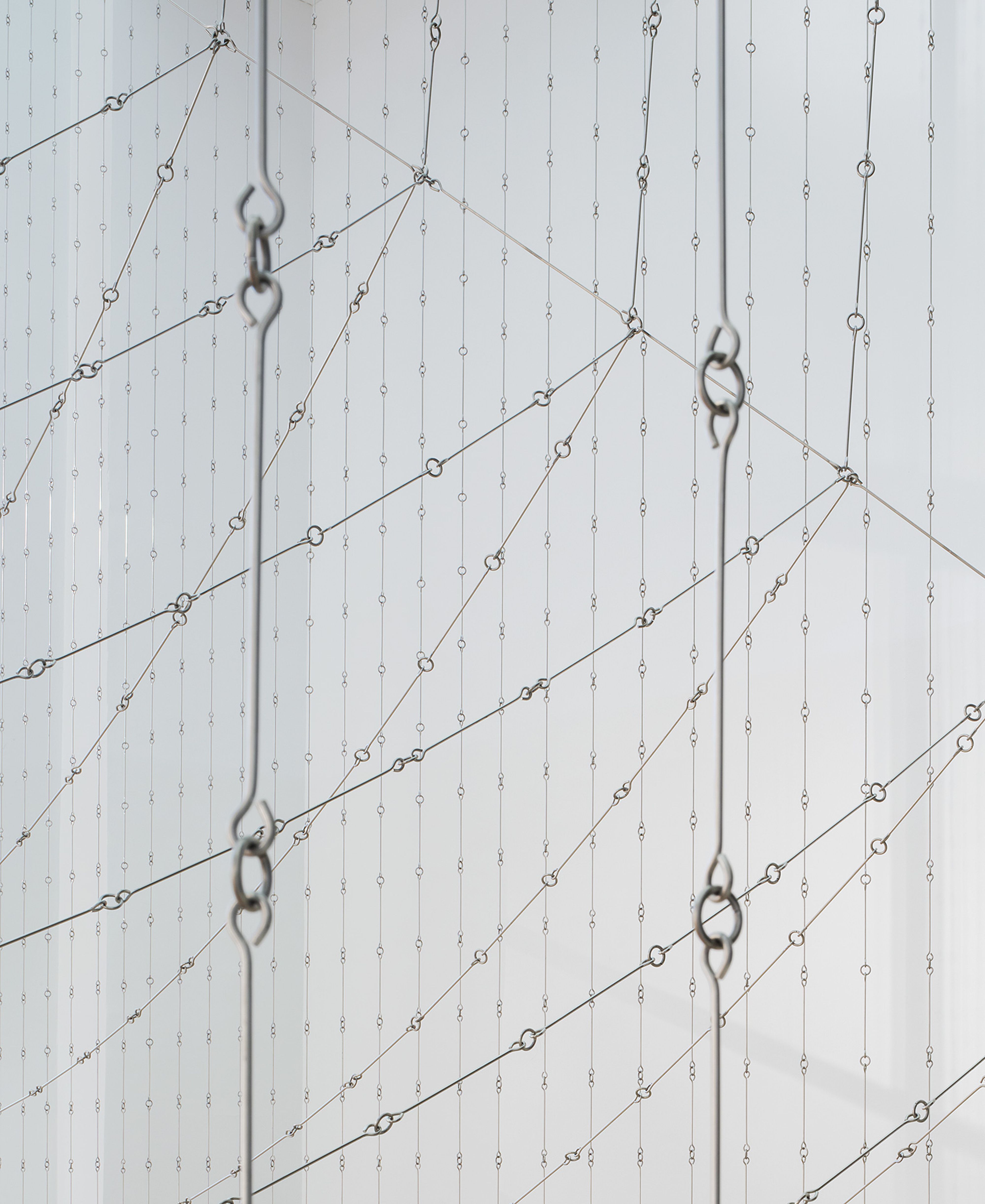
The Buell Center and AD—WO, Columbia University, 100 Links: Architecture and Land, in and out of the Americas, 2023. Photo by Tom Harris.
Unsurprisingly, the biennial’s most straightforward subject — materiality — accounts for its most tangible exponents, which is not a bad thing given architecture has to remain in touch with physical form to some degree if it’s expected to help solve the world’s pressing social, ecological or economic problems. Novel material propositions can be experienced throughout CAB 5, including Leibinger’s aforementioned cardboard palace; the recycled plastic Norman Teague used for parts of the prototype of a potential West Side monument to Frederick Douglass (one of several entries that leaves open the question of actual implementation, fulfilling the titular ‘rehearsal’ disclaimer); Achim Menges/ITECH’s HygroShell humidity-molded timber; SOM’s zero-carbon ‘algae concrete’; and the miles of discarded rubber pipes New Delhi-based Asim Waqif used to triumphantly uglify, the way Demna’s Balenciaga might, another CCC lobby.
What will happen with all the resources used for the four-month showcase is a recurrent preoccupation. Even the exhibition’s bare-bones museography by Mexico City native Leticia Pardo — mostly scaffolding that can easily be reused in a different context — is smartly designed to minimize waste. Somehow, the biennial shows that recycling materials has the potential to produce greater good than recycling buildings, which these days tends to stand for the commoditization by a few of what once belonged to all. Until the last day of 2023, large jute tapestries by Ibrahim Mahama hang from the balconies of the Thompson Center. With seemingly little irony, the exhibition-makers draped textiles produced to commemorate the individual effects of global trade over one of the great American civic spaces of the 20th century before its surrender to a tech giant. The Thompson is not the only Chicago landmark to undergo a transition from public to private use in order to survive. The city’s Old Post Office, an art deco behemoth from 1932, was reborn in 2021 as office space for Uber and other corporations. And yet, if it weren’t for the erstwhile search engine company, Helmut Jahn’s fantastic oddity might not be preserved at all. According to Hulsebos-Spofford, the CAB 5 co-director, “Google is really interested in maintaining a public square for the city,” and ‘only’ plans to shut out the masses from the atrium’s upper levels. Like other tantalizing propositions in this biennial, time will tell if promise becomes reality.
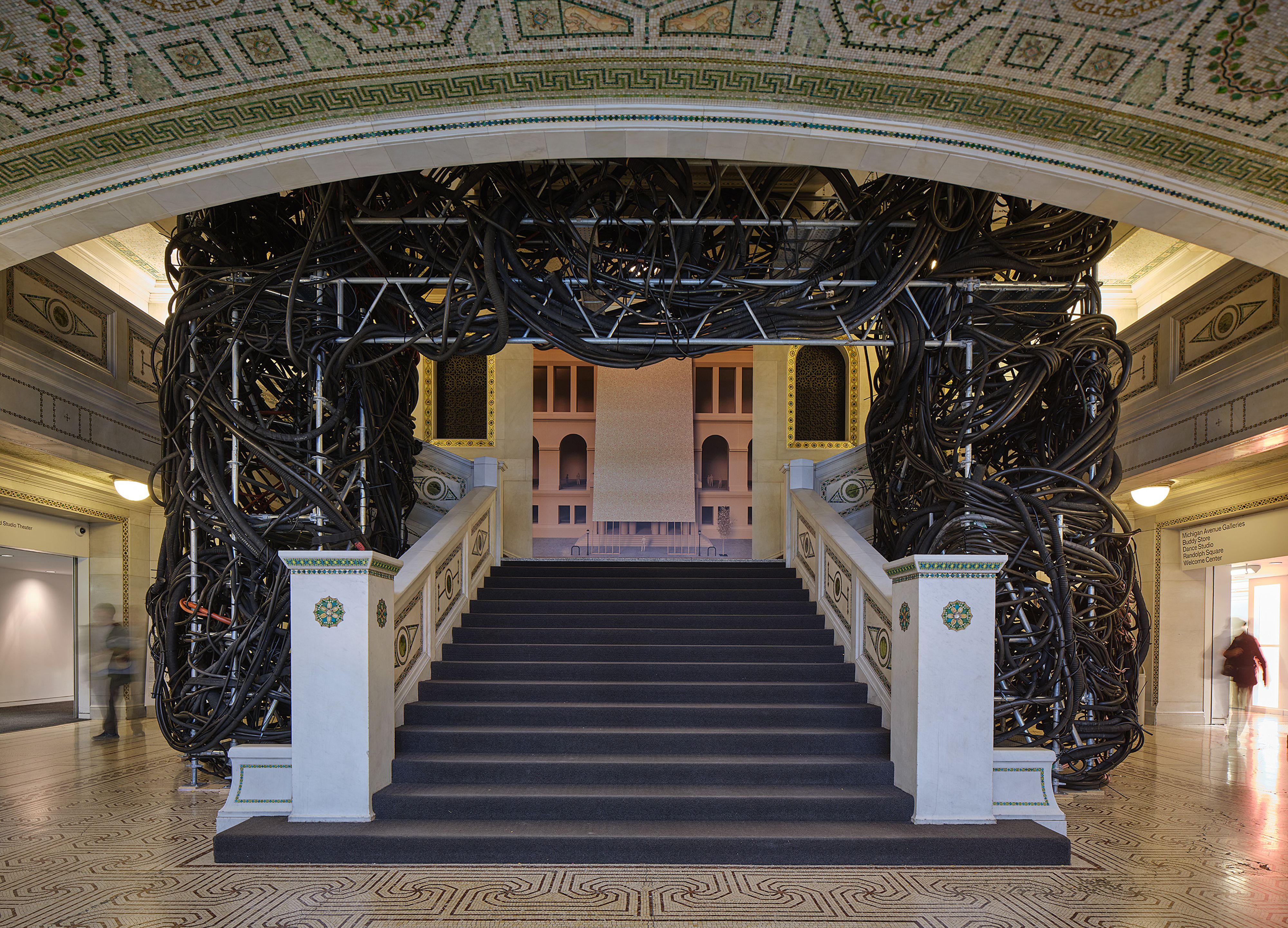
Asim Waqif, Pretty Wrecked, 2023. Photo by Tom Harris.